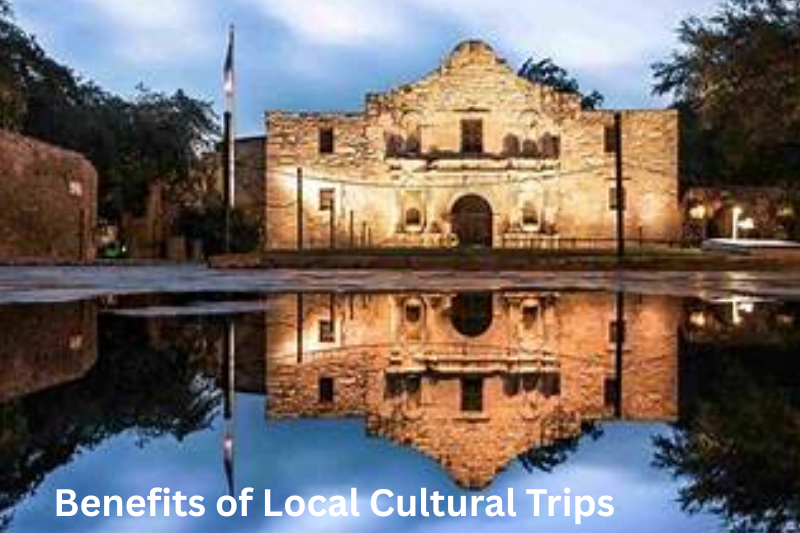When people think about cultural travel, they often imagine hopping on a plane to explore distant lands—wandering through Europe’s cathedrals, Asia’s temples, or Africa’s ancient villages. But the truth is, meaningful cultural experiences don’t have to be far away. Sometimes, they’re right in your own community, waiting to be discovered.
Local cultural trips are becoming increasingly popular among travelers who want authentic experiences without the cost and time commitment of long-distance travel. Whether you live in a small town or a large city, your area is likely full of fascinating traditions, heritage sites, and local stories worth exploring.
In this article, we’ll explore detailed local cultural trips ideas, along with their benefits and drawbacks, to help you plan your next meaningful getaway close to home.
1. Visit Historical Sites and Heritage Centers

History is the backbone of any culture. Exploring local historical sites helps you understand how your community evolved over time and what shaped its present-day identity.
Ideas to explore:
- Tour restored heritage homes or architectural landmarks in your area.
- Visit local museums, war memorials, or cultural heritage centers.
- Join a guided walking tour that focuses on your town’s or city’s historical district.
Many historical sites offer interactive experiences such as re-enactments, storytelling sessions, or traditional craft demonstrations that make learning engaging and memorable.
Benefits:
- Deepens appreciation for local history and culture.
- Often low-cost or free.
- Supports preservation of heritage sites through visitor funding.
Drawbacks:
- May have limited exhibits or seasonal opening hours.
- Some sites might require advance booking or guided tours only.
2. Explore Local Art and Craft Scenes
Art is a living expression of culture. Local artists and craftsmen tell stories through their work—stories of tradition, community, and creativity.
Ideas to explore:
- Attend open studio tours or community art walks.
- Visit art galleries that feature regional artists.
- Take a workshop in traditional crafts like pottery, weaving, or folk painting.
Many small towns have art cooperatives or weekend markets showcasing handmade goods. Exploring these spaces lets you meet the makers and learn directly from them.
Benefits:
- Encourages creativity and appreciation for local talent.
- Directly supports small artists and artisans.
- Provides hands-on experiences and new skills.
Drawbacks:
- Workshop fees or materials may be expensive.
- Some rural art communities may have limited access or schedules.
3. Take a Food Heritage Tour
Food is one of the most enjoyable ways to experience culture. Traditional recipes, local ingredients, and regional cooking styles all tell stories about how communities live and celebrate.
Ideas to explore:
- Join a food tour that highlights traditional dishes or historical eateries.
- Visit farmers’ markets and talk with vendors about local produce.
- Take a cooking class focused on your region’s cuisine.
You can even create your own “food heritage trail” by mapping out bakeries, family-run restaurants, and markets that showcase authentic local flavors.
Benefits:
- Engages multiple senses—taste, smell, and touch—making it a memorable experience.
- Helps preserve traditional cooking methods and recipes.
- Supports local farmers and small food businesses.
Drawbacks:
- Food tours can be pricey in popular areas.
- Some experiences may not cater to specific dietary restrictions.
4. Attend Local Festivals and Cultural Events
Festivals are a vibrant reflection of local traditions. They bring people together through dance, music, art, and community spirit.
Ideas to explore:
- Participate in harvest festivals, folk dance celebrations, or regional fairs.
- Attend open-air concerts or cultural film screenings.
- Volunteer at a local event to experience it from behind the scenes.
Even small communities host annual celebrations that reveal a lot about local values and customs.
Benefits:
- Immersive and energetic way to experience community culture.
- Opportunities to meet locals and make new friends.
- Encourages cultural pride and social connection.
Drawbacks:
- Can be crowded and noisy, which may not suit everyone.
- Events are often seasonal and weather-dependent.
5. Explore Indigenous and Folk Traditions
Learning about indigenous or folk cultures in your area offers a powerful way to connect with the original roots of your region. These traditions often include storytelling, music, craftwork, and rituals passed down through generations.
Ideas to explore:
- Visit indigenous cultural centers or folk museums.
- Attend traditional music or storytelling events.
- Buy authentic handmade crafts directly from indigenous artisans.
When participating in these activities, approach with respect and curiosity, recognizing that these are living traditions, not just tourist attractions.
Benefits:
- Provides deep insight into your region’s heritage.
- Promotes respect and understanding for diverse cultural identities.
- Often helps sustain indigenous and rural economies.
Drawbacks:
- Requires sensitivity and awareness of cultural boundaries.
- Authentic experiences may be harder to access in urban settings.
6. Take a Culture Walk Around Your Neighborhood
Cultural discovery doesn’t always mean planning a big trip. You can find history and heritage right on your doorstep.
Ideas to explore:
- Walk around your neighborhood to observe public art, architecture, and historical plaques.
- Visit cemeteries, monuments, or parks with cultural significance.
- Speak with long-time residents or local historians about community changes over time.
This type of exploration is low-cost, spontaneous, and often surprisingly rewarding.
Benefits:
- Completely free and easy to do anytime.
- Encourages mindfulness and connection to your surroundings.
- Often leads to discovering overlooked places of interest.
Drawbacks:
- May lack structure or guidance for deeper learning.
- Limited opportunities for interaction or hands-on experience.
You may also like to read these posts:
Travel Safety Tips 2026: A Complete Guide to Safe and Smart Traveling
Money Saving Travel Tips: How to Travel More While Spending Less
International Travel Tips Guide: Everything You Need to Know Before Traveling Abroad
Travel Tips for Families: A Complete Guide to Stress-Free and Enjoyable Adventures
Benefits of Local Cultural Trips

Local cultural trips offer more than just entertainment—they strengthen personal and community bonds.
Key benefits include:
- Affordability: No flights or major travel expenses required.
- Sustainability: Lower carbon footprint than international travel.
- Community Support: Money spent locally benefits small businesses and artisans.
- Cultural Awareness: Deepens understanding of your own region’s history and traditions.
- Personal Growth: Encourages curiosity, empathy, and appreciation for diversity.
Drawbacks of Local Cultural Trips
While rewarding, local cultural trips also come with a few limitations:
- Limited Variety: Smaller regions may offer fewer cultural attractions.
- Accessibility Issues: Some heritage sites may lack public transport or wheelchair access.
- Event Timing: Festivals and markets are often seasonal, so timing matters.
- Familiarity Bias: Locals may overlook attractions that feel “too close to home.”
Being aware of these challenges helps you plan ahead and make the most of every experience.
Final Thoughts
Exploring local culture is a journey of rediscovery. It reminds you that you don’t need to travel far to learn, connect, and grow. Every community—big or small—has stories to tell, traditions to share, and people keeping them alive.
So next time you’re looking for inspiration, consider trying one of these local cultural trips ideas. Take a weekend to explore your local art, food, or history scene. You may be surprised by how rich and meaningful your own hometown can be when you look at it through the lens of culture.
FAQs
1. What are local cultural trips?
Local cultural trips are travel experiences focused on exploring the traditions, heritage, art, and history of your own city, town, or region. They allow you to connect with local culture without traveling far from home.
2. Why should I consider a local cultural trip?
Local cultural trips are affordable, eco-friendly, and offer opportunities to support local businesses and artisans. They help you learn about your community’s history, traditions, and creative expressions in a meaningful way.
3. What are some examples of local cultural trips?
Visiting historical landmarks or heritage centers
Exploring local art galleries or craft workshops
Attending traditional food tours or cooking classes
Participating in festivals, fairs, and cultural events
Discovering indigenous or folk traditions
Taking self-guided cultural walks around your neighborhood
4. Are local cultural trips suitable for families?
Absolutely! Many local cultural trips can be family-friendly, such as visiting museums, attending festivals, or joining art and cooking workshops. They provide both fun and educational experiences for children and adults alike.
5. How can I find local cultural events in my area?
You can check community websites, social media pages, local tourism boards, or event calendars. Libraries, museums, and cultural centers often post upcoming workshops, exhibitions, and festivals.




